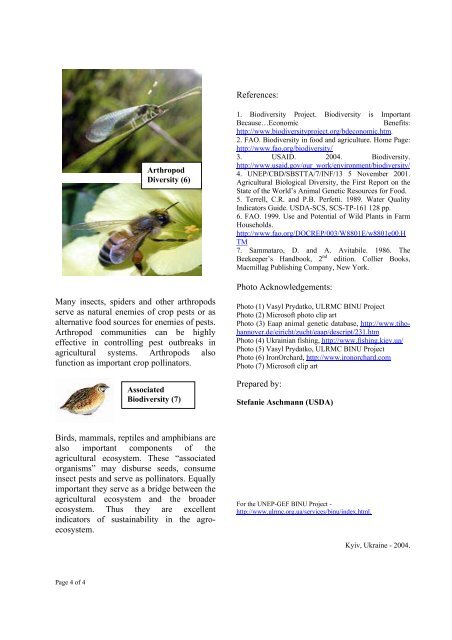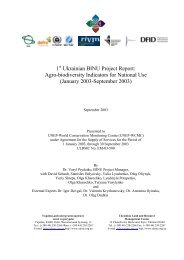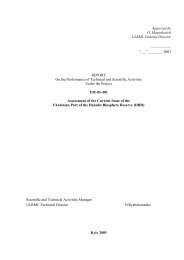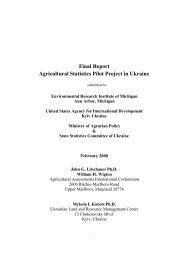What are the Benefits of Agricultural Biodiversity?
What are the Benefits of Agricultural Biodiversity?
What are the Benefits of Agricultural Biodiversity?
Create successful ePaper yourself
Turn your PDF publications into a flip-book with our unique Google optimized e-Paper software.
References:<br />
Arthropod<br />
Diversity (6)<br />
Many insects, spiders and o<strong>the</strong>r arthropods<br />
serve as natural enemies <strong>of</strong> crop pests or as<br />
alternative food sources for enemies <strong>of</strong> pests.<br />
Arthropod communities can be highly<br />
effective in controlling pest outbreaks in<br />
agricultural systems. Arthropods also<br />
function as important crop pollinators.<br />
Associated<br />
<strong>Biodiversity</strong> (7)<br />
1. <strong>Biodiversity</strong> Project. <strong>Biodiversity</strong> is Important<br />
Because…Economic<br />
<strong>Benefits</strong>:<br />
http://www.biodiversityproject.org/bdeconomic.htm.<br />
2. FAO. <strong>Biodiversity</strong> in food and agriculture. Home Page:<br />
http://www.fao.org/biodiversity/<br />
3. USAID. 2004. <strong>Biodiversity</strong>.<br />
http://www.usaid.gov/our_work/environment/biodiversity/<br />
4. UNEP/CBD/SBSTTA/7/INF/13 5 November 2001.<br />
<strong>Agricultural</strong> Biological Diversity, <strong>the</strong> First Report on <strong>the</strong><br />
State <strong>of</strong> <strong>the</strong> World’s Animal Genetic Resources for Food.<br />
5. Terrell, C.R. and P.B. Perfetti. 1989. Water Quality<br />
Indicators Guide. USDA-SCS, SCS-TP-161 128 pp.<br />
6. FAO. 1999. Use and Potential <strong>of</strong> Wild Plants in Farm<br />
Households.<br />
http://www.fao.org/DOCREP/003/W8801E/w8801e00.H<br />
TM<br />
7. Sammataro, D. and A. Avitabile. 1986. The<br />
Beekeeper’s Handbook, 2 nd edition. Collier Books,<br />
Macmillag Publishing Company, New York.<br />
Photo Acknowledgements:<br />
Photo (1) Vasyl Prydatko, ULRMC BINU Project<br />
Photo (2) Micros<strong>of</strong>t photo clip art<br />
Photo (3) Eaap animal genetic database, http://www.tihohannover.de/eiricht/zucht/eaap/descript/231.htm<br />
Photo (4) Ukrainian fishing, http://www.fishing.kiev.ua/<br />
Photo (5) Vasyl Prydatko, ULRMC BINU Project<br />
Photo (6) IronOrchard, http://www.ironorchard.com<br />
Photo (7) Micros<strong>of</strong>t clip art<br />
Prep<strong>are</strong>d by:<br />
Stefanie Aschmann (USDA)<br />
Birds, mammals, reptiles and amphibians <strong>are</strong><br />
also important components <strong>of</strong> <strong>the</strong><br />
agricultural ecosystem. These “associated<br />
organisms” may disburse seeds, consume<br />
insect pests and serve as pollinators. Equally<br />
important <strong>the</strong>y serve as a bridge between <strong>the</strong><br />
agricultural ecosystem and <strong>the</strong> broader<br />
ecosystem. Thus <strong>the</strong>y <strong>are</strong> excellent<br />
indicators <strong>of</strong> sustainability in <strong>the</strong> agroecosystem.<br />
For <strong>the</strong> UNEP-GEF BINU Project -<br />
http://www.ulrmc.org.ua/services/binu/index.html.<br />
Kyiv, Ukraine - 2004.<br />
Page 4 <strong>of</strong> 4






